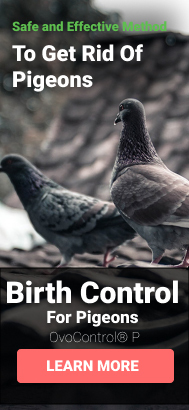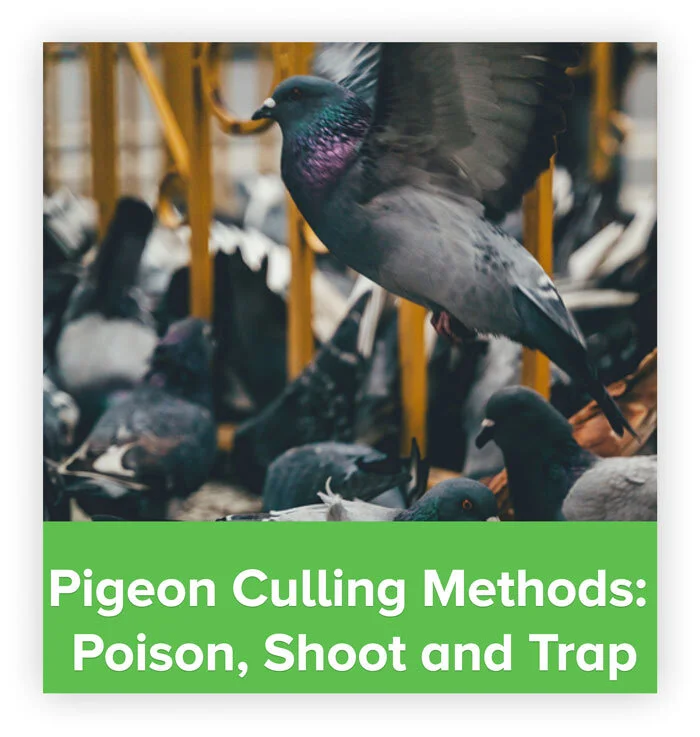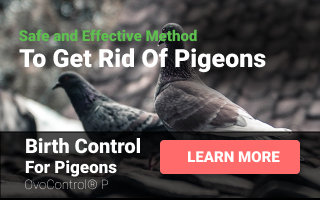Pigeon Culling Methods: Poisoning, Shooting, Trapping and Raptors
Written by Erick Wolf
Why should pigeons be removed from your property or facility?
At 350 grams, pigeons are relatively large birds and consume a total of 60 grams of dry matter and water each day. What goes in eventually comes out the other end as a combination of urine and feces. Consider that a relatively small population of 100 birds will deposit up to 4,800 pounds of “poop” each year. Ultimately, this can represent a serious source of contamination and disease.
What are the options for culling pigeons?
There are effectively four options for culling pigeons – three are under your control and one is controlled by nature. The three options we can control are poisoning, shooting, and trapping (and euthanizing). The ultimate natural culling option is a raptor or bird of prey.
| Method/Product | Best Used For | Advantages | Disadvantages |
| Culling | |||
| Shoot | Killing | Immediate action, low cost | Generally prohibited in public. Represents a harvest as opposed to a control program |
| Poison | Killing | Immediate action | Non-target risks; socially unacceptable, short-term solution; dead and dying birds |
| Trap and euthanize | Killing | Immediate action | Often unacceptable where people are present. Short-term effects; birds get “trap shy” |
| Raptors | Predator and prey | Pigeons are a natural prey species; environmentally sound solution | Mating pairs are difficult to attract under most urban conditions. Raptors migrate and will leave the area part of the year |
How effective is poisoning pigeons?
Like other pigeon control methods, the casual observer could conclude that poisoning pigeons is extremely effective. Just like trap/euthanize or shooting, the technique is tangible, and the effect is immediate. In reality, poisoning pigeons only provides the illusion of effective control, since other birds quickly move in or the remaining flock quickly repopulates with increased reproduction. Since the birds breed so quickly, a site with 100 pigeons who poisons 50 will, within a few weeks, have 100 again. This results in a chronic cycle of killing them with little long-term effect. Just like other methods to increase mortality, poisoning pigeons represents a short-term control strategy.
Using poison to kill pigeons - good or bad idea?
Pigeons are considered a pest. Nevertheless, they are still birds and have a different place in our society, than say, rats or cockroaches. Killing pigeons with poison may sound like a good idea to quickly remove them, but, there are many other options to get rid of pigeons in humane way. unfortunately, the poison option is fraught with many different hazards and risks. Take for example,
What if you kill the wrong bird? The non-target risks are huge. Federal, state, and local wildlife agencies will jump into action when the first protected bird is killed, and the fines are immense.
What if you kill a pet? Not only can the poison intoxicate the bird, but the neighbor’s dog might eat it as well.
What if you cannot find the dead birds and something else eats it? Secondary effects represent a serious hazard.
Perhaps more hazardous than any of the above is the public reaction. Everyone with a smartphone will video the action for a report on the nightly news.
What is the history of bird poisons?
Before providing more details on this topic, it is a good idea to better understand the history of poisons for birds, aka, avicides, as well as other pesticides that are hazardous to birds.
People have been poisoning pests, including birds, for hundreds of years. It is cheap and, theoretically, easy to do. Just like insects, birds are fundamentally sensitive to a broad range of chemistries, much more so than mammals.
The original bad actor in the world of pesticides and birds was DDT. Beginning in the 1940’s, people were using this active ingredient extensively around the world as an insecticide. It is especially effective against mosquitos who are carriers for typhus and malaria. Unfortunately, based on the chemistry, DDT accumulates in the food chain and ends up in relatively high concentrations in apex predators, the most famous of which are the Peregrine falcon and Bald eagle. These species were nearly lost when DDT residues caused their eggshells to thin and crack. DDT was banned for all domestic uses in the USA in 1972.
While DDT was bad for birds, it was never developed or intended to kill them. That said, there are avicides specifically developed for poisoning birds. Most of this work was a result of taking compounds known to be toxic in other species and developing them for avian species. In the 1950’s and 1960’s, strychnine and fenthion, an organophosphate, were introduced as avicides. With one sole exception, all of the commercially available avicides were banned by EPA for non-target hazards in the late 1990’s. The exception is a product with the active ingredient, 4-aminopyrimidine (aka, AvitrolTM).
Is it legal to poison birds in the USA?
The first distinction we should make are birds that are considered “pests” and the ones that are not. You may consider a seagull a pest bird, but like so many others, they are protected by the US Migratory Bird Treaty Act or “MBTA”. In the USA, the only birds that do not have any protection are pigeons, English house sparrows and European starlings. Pigeons are considered domesticated and anything goes. Unlike any bird protected under MBTA, you can do anything to these species if it does not conflict with animal welfare ordinances in your community. Depending on your location, poisoning birds may be prohibited.
The USA is one of few first world markets where poisoning birds remains sanctioned. Most of the world banned the practice decades ago although the USA, parts of Canada, Australia and New Zealand still permit the use of avicides.
The last remaining avicide registered by USEPA to poison birds is 4-aminopyrimidine or Avitrol. This poison is classified as a Restricted Use Pesticide (“RUP”) and may only be used by licensed applicators. Seek out advice from your local and state regulatory agencies before you consider using this product.
What are the pigeon poisons available in the USA?
As described above, the only remaining registered poison for pigeons commercially available in the United States is Avitrol (4-aminopyrimidine). The product is manufactured and marketed by Avitrol Corp, Tulsa, OK. It is an avian toxicant used as a chemical frightening agent in pigeons, starlings, blackbirds, sparrows, crows, and house sparrows. The active ingredient, 4-aminopyridine, is an acute oral toxicant, which acts on the central and motor nervous system. The product is registered as a restricted-use pesticide by EPA and approved for use in all states, although only through pest control applicators with a restricted use pesticide license.
Avitrol is toxic to all vertebrate species, not just birds. Its action on the motor nervous system usually causes behaviors characteristic of an epileptic seizure or convulsion. Birds eating treated bait will be affected in a manner that, varying by species, will artificially cause them to emit distress and alarm cries and visual displays used by their species when they are frightened or injured. This may include flying erratically, vocalizing, trembling, dilation of the pupils and other symptoms consistent with the loss of motor control. This behavior can frighten the flock and cause it to leave the site.
An option to Avitrol is an avicide developed by the US Department of Agriculture (“USDA”) called DRC-1339. Unlike Avitrol, the intent is not to frighten birds but to poison them. Birds die a slow, "nonviolent" death by uremic poisoning and congestion of major organs. USDA Wildlife Service limits the use of this product, that's why it is typically applied only in agricultural settings. Nevertheless, treated birds can “fly back to town” and extensive bird kills have been reported in urban areas over the years.
Are there other pigeon poisons available around the world?
There are other avicides registered in different markets around the world. The most notable one is alphachloralose, a stupefying agent which is used both in birds and rodents. At lower doses, the product will simply put the bird to sleep; at higher doses, the effect is irreversible.
Prior to the advent of less toxic substances, thallium was used to poison birds and rodents. Some will even use antifreeze to poison birds, although this method is illegal and subject to huge non-target risks.
How does pigeon poison work?
Poisons are typically mixed with large grains and fed to the birds. Larger grains, for example, whole corn, limits the number of smaller birds that can consume the bait. Tactile poisons like fenthion were banned decades ago.
What are the advantages of using poison to kill pigeons?
Historically, avicides represented a low-cost alternative. Furthermore, the action of an avicide is tangible and immediate. Like shooting the birds, the effects are terminal and rapid, easy to measure. Unfortunately, poisoning birds is inherently risky since you cannot control other birds from ingesting the bait and non-targets are subject to the same effects.
What are the disadvantages of using poison to kill pigeons?
In addition to the non-target hazards, the risks of using poison on pigeons or other birds is extreme. More than anything else, if the poisoning is conducted where anyone can observe the carnage, it will be reported to the authorities and the news. Irrespective of the legality, you risk severe public outrage from the community and others that value birds, even pigeons. Furthermore, the potential for non-target poisoning of other birds, pets or even children, is an unacceptable risk.
Are there any foods we can use to poison pigeons?
If toxic to mammals, any given substance is most likely even more toxic to birds. Conversely, if a food is safe for people to eat, it is likely safe for a pigeon as well. The stories about rice, salt, Alka-Seltzer, spices, etc. represent urban legends that have long ago been debunked. Feeding uncooked rice to pigeons on the theory that they will expand and explode is an urban legend.
What are the Other Methods to Cull Pigeons?
There are two other methods commonly used to cull pigeons -- live trapping, and shooting. Both methods suffer from many of the same limitations inherent in poisoning the birds. Often, live trapping or shooting only removes a portion of the population. Whatever remains represents the core of the new population which rapidly expands to fill the void. If you consider how rapidly the birds breed, it does not take much time – a few weeks or months – and the population is right back where it started. In most cases, increasing the mortality in the flock – trap, shoot or poison – resembles more of a harvest than an actual control program.
Is Shooting Pigeons an Acceptable Method of Control?
Yes, shooting pigeons is sometimes an acceptable method of control but there are many different limitations. First and foremost, shooting in an urban area is prohibited – the police will come even for an air rifle. Shooting birds, even on your own property is not recommended. This activity most often leads to unintended consequences.
Therefore, unless you are in a very remote or rural location, this option is not acceptable. Furthermore, all OSHA inspected facilities have a prohibition on guns at the workplace. The only area where shooting remains a realistic option is on a rural farm.
How Are Traps Used for Pigeons?
Only live traps are used for pigeons. There is a wide array of options, although they all have the same basic configuration. During a conditioning period, the trap is baited with grains and the pigeons can walk in and out of the trap through a door. Once acclimation is complete, the door is switched to one-way and the birds can no longer exit the trap. Trapped pigeons must be euthanized – they cannot be relocated. Pigeons have a strong homing ability and relocated pigeons will mostly find their way right back to their original location.
Can Trapping be Combined with Other Methods of Control?
Yes, consistent with the philosophy of integrated pest management (“IPM”), trapping, a lethal method, can be combined with other non-lethal methods. For example, a trapping program can be used in parallel with birth control. In this way, the population is managed both by increasing mortality and reducing pigeon reproduction for the best possible outcome.
What about Raptors for Pigeon Control?
The ultimate lethal and natural pigeon control method is a raptor or bird of prey. Pigeons are considered a prey species and there are many different hawks, owls and falcons that will naturally prey on pigeons. The Peregrine falcon is in a class by itself and can actually take a pigeon in flight. Unfortunately, naturally occuring raptors are completely outside our immediate control. The only realistic option is to install nesting habitat for the raptors you are interested in attracting. A good example is a owl box. Building plans are typically available through your respective State Coop Extension Service.
Summary
Although poisons and other methods to increase mortality can be effective in killing birds, the risks truly outweigh the benefits. Seek out other safe, effective, and humane techniques that can help manage your pigeon problem.
Learn more about pigeon control alternatives:
- Pigeon Culling Methods: Poisoning, Shooting, Traps and Raptors
- Reducing Pigeon Reproduction: A Long-Term Solution for Pigeon Control
- Physical Exclusion of Pigeons – Spikes, Wires, Nets and Slides
- Pigeon Deterrents - Effigies, Sonic Emitters, Propane cannon
- Bird Netting: Everything you Should Know





